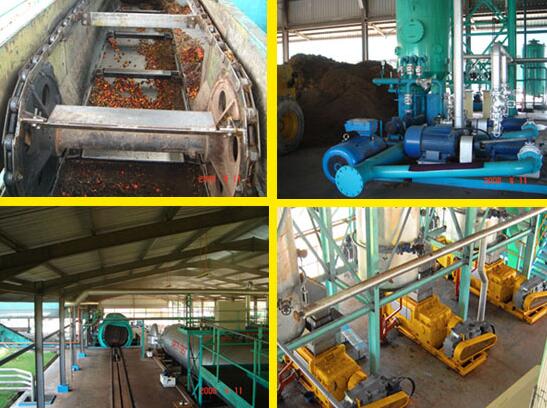China leading palm oil mill plant machine manufacturer and supplier
Email:info01@cnoilmachine.com
The optimal conditions for palm oil extraction revolve around four key dimensions: raw material quality, pretreatment, pressing technology, and environmental control. These conditions aim to ensure both high oil yield and excellent oil quality (low acid value, good color, and good nutrient retention). Specific conditions are as follows:
Fruit maturity is crucial
Select fully ripe oil palm fruit—the peel should be orange-red or bright red, the bunches should be plump and elastic, and the pulp should easily separate from the shell. Higher maturity results in a higher oil content (up to 50%-60%). Unripe fruit has an oil content of only about 30%, and overripe fruit is prone to rotting and spoilage, increasing the acid value of the oil.
Ensuring Fresh and Unspoiled Raw Materials
Oil palm fruit must be processed within 24 hours of harvesting (no later than 48 hours) to prevent fermentation and enzymatic hydrolysis of the pulp—fermentation increases free fatty acids (raising the acid value), darkens the oil color, intensifies the odor, and severely affects oil quality.
Raw Material Pretreatment:
Impurity Removal and Cleaning
Remove impurities such as dead branches, fallen leaves, and soil from the fruit bunches. Quickly rinse the surface with clean water to prevent impurities from being carried into subsequent processes, causing equipment wear and oil contamination.

Crushing: Thorough Separation of Pulp and Shell
Use a crusher to crush the oil palm fruit bunches to a suitable particle size (allowing the pulp to detach from the shell without breaking the shell). The separated pulp (containing a small amount of fiber) enters the cooking stage, while the shell can be recycled for fuel.
Cooking: Precise Control of Temperature and Time
Temperature: 105-110℃ (High temperature can destroy the cell structure of the pulp, reduce oil viscosity, and inhibit lipase activity, reducing the formation of free fatty acids);
Time: 30-45 minutes (Insufficient cooking makes it difficult for oil to be extracted; overcooking easily causes the pulp to gelatinize, affecting the oil yield and oil quality);
Method: Indirect steam heating to ensure even heating and avoid localized overheating.
Before pressing: Proper softening of the pulp. After steaming, the pulp is fed into an extruder to soften it, forming a uniform "oil slurry" consistency. This increases the contact area between the oil and the screw press, facilitating smooth oil extraction during pressing.
Physical pressing (mainstream process)
Temperature: Cold pressing (high-end oil) is controlled below 40℃ to retain nutrients such as Vitamin E and phytosterols; hot pressing (mass-production oil) is controlled at 100-120℃ to increase oil yield (5%-8% higher than cold pressing);
Pressure: The screw press pressure gradient is set to "low at the front and high at the back," with an inlet pressure of 0.5-1MPa and an outlet pressure of 3-5MPa (too low pressure results in insufficient oil extraction; too high pressure leads to pulp carbonization and oil contamination);
Screw speed: 30-50 r/min (too high a speed results in short material residence time and low oil yield; too low a speed results in low efficiency and localized overheating). 2. Extraction Assistance (for Residual Oil from Pressed Cake)
If a combined "pressing + extraction" process is used, for oil cakes with a residual oil content of 5%-8% after pressing, extraction with No. 6 solvent oil (food grade) at a temperature of 50-60℃, a material-to-liquid ratio of 1:6-1:8, and an extraction time of 2-3 hours can reduce the residual oil content to below 1%, increasing the total oil yield.
Production Environment: Dry, Clean, and Temperature-Controlled
The workshop temperature should be controlled at 25-30℃, and the relative humidity ≤65% (a humid environment easily leads to oil absorbing water and deteriorating, and equipment corrosion); the workshop should be kept clean to prevent dust and odors from contaminating the oil.
Crude Oil Filtration: Timely Impurity Removal
The crude oil extracted from pressing (containing fruit pulp fibers, dust, and other impurities) must be immediately filtered using a plate and frame filter or centrifugal filter with a filtration accuracy ≤5μm to remove impurities before being sent to the refining stage to prevent impurities from accelerating oil oxidation.
The filtered crude oil is temporarily stored in stainless steel tanks, protected from light and sealed. The temperature is controlled at 20-25℃, and the storage time should not exceed 72 hours. It should then be processed as soon as possible (degumming, deacidification, decolorization, and deodorization) to reduce the risk of increased acid value.
The core conditions most suitable for palm oil extraction can be summarized as: mature and fresh oil palm fruit; cooking at 105-110℃ for 30-45 minutes; pressing with a gradient pressure of 3-5MPa; a dry and clean environment at 25-30℃; and timely filtration and temporary storage. Meeting these conditions ensures an oil yield (40%-45% with physical pressing and over 50% with combined extraction) and produces palm oil with low acid value, light color, and stable quality.
If you are interested in our palm oil machine and palm oil mill plant. You can contact us through online consultation, filling out the form below, email, phone, etc. Our engineers will customize the most suitable plan and best price for you.